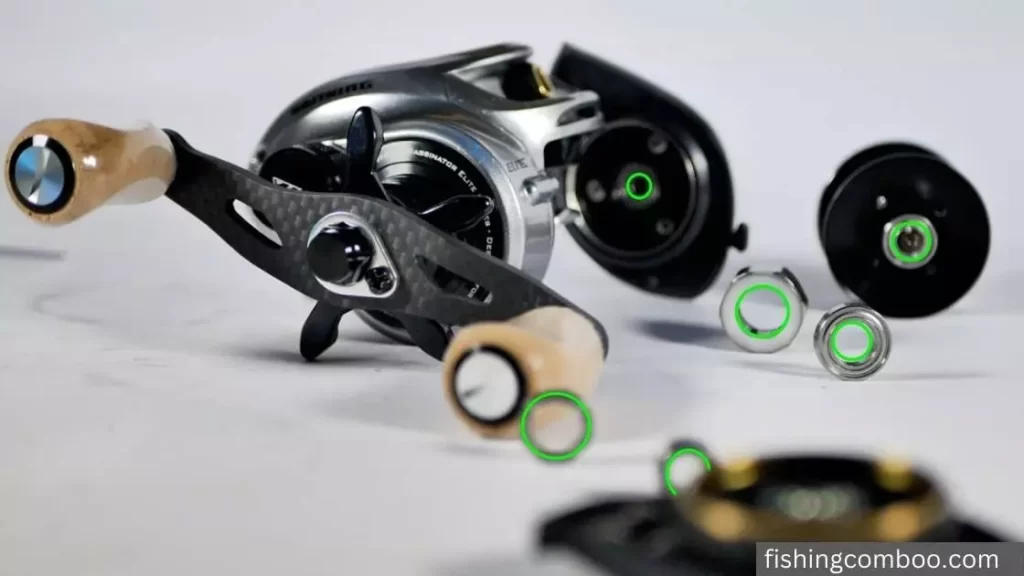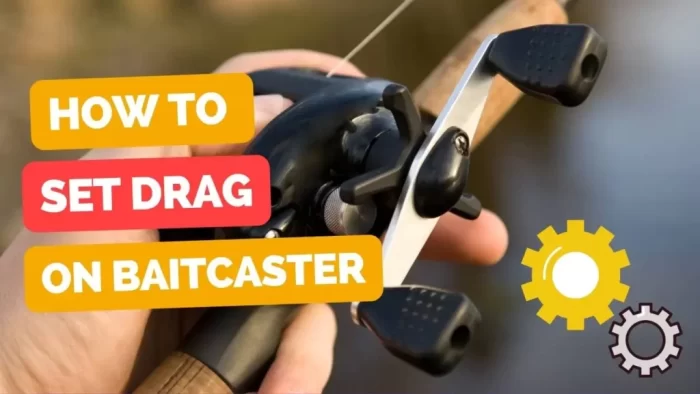If you’ve ever gone fishing, you know how important it is to have the perfect drag on your baitcaster. The reel drag helps control the line when a fish bites and ultimately affects the success of your catch!
Unfortunately, many anglers need help to set the proper tension when attempting to fix their baitcaster’s drag. This article will guide you through how to set drag on baitcaster so you can have maximum success while out fishing!
We’ll also discuss common problems and tips for fixing drag on your bait caster. With this knowledge, you’ll be able to confidently adjust the tension of your baitcaster line and catch those big fish!
Let’s get started!
What is Drag

Drag is a mechanism on baitcasting or fishing reels that helps to keep the line from breaking or being pulled out of the guides. It adds resistance when a fish pulls against the line, allowing anglers to fight and land larger catches.
Setting the drag properly is essential to maximize your chances of success while fishing with a baitcaster.
How to Set Drag on Baitcaster Comprehensive Guide
Setting the drag on your baitcaster is simple, but you need the practice to get it right. You can choose two ways to configure your drag: manually adjusting it or utilizing a scale. Let’s look at both approaches in further detail.
Note: The drag mechanism or drag setting varies for different types of reels and fishing conditions. Before setting the drag, take note of the manufacturer’s instructions or basic guidelines for your particular reel.
Setting Drag Manually
The proper drag setting is as follows:
1. First, ensure that you have enough lines on your fishing reel for your target fish. If you don’t have enough, your drag will not be able to fight a larger catch effectively.
2. Next, set the baitcaster’s drag adjustment knob or lever on your baitcaster. This should be located on the side of the reel and is used to adjust the pressure put on your line when a fish pulls against it. It is usually like a star shape or a lever. The drag can be tightened when you rotate it clockwise, and rotating counterclockwise loosens it. Start by setting it to its lowest level, then slowly increase it until you reach a comfortable tension.
3. Once you have set the tension knob or lever, you will want to check the drag washer. To do this, pull the line and look to see if it is moving freely. If not, adjust the tension knob or lever until it can rotate without resistance.
4. Now that your drag has been set correctly, you should test it by pulling on the line with your hand. You should feel some resistance, and the line should move slowly.
5. Finally, you should check for any signs of damage to your line or reel after each use. This will help ensure that your drag is properly working and that your line is in good condition.
Read About: Best Baitcaster Combo for Beginners
Setting Drag Using Scale
When setting the drag on a baitcaster, using a scale is one of the best ways to ensure accuracy. This process can help you achieve consistent performance from your reel and ultimately improve your fishing success.
What is Scale:

A scale is a dependable instrument designed to evaluate the amount of tension in your line accurately. Depending on the scale you have, it may have a hook or clamp that can be attached to the end of your line or a fishing reel arm where the spool is placed.
Using a scale for setting drag allows for more precision than manual methods, as you can accurately measure the force being applied.
Follow these straightforward steps for setting drag using a scale:
1. Attach a scale to the line of your bait caster. Ensure you securely attach the clip on the scale to the eyelet at least four inches up from the reel.
2. Turn on your baitcaster and hold onto it with one hand, then slowly crank up the drag tension until you feel resistance when slowly pulling out the line.
3. Look at the scale and note how intense is the line pressure. Start setting the drag tension with this as your baseline.
4. Adjust the drag settings until you reach a comfortable level of tension that works with your specific lure and fishing conditions. You want to make sure it’s not too tight or too loose.
5. Check the scale to see if the tension is what you want it to be. If not, adjust until you get the desired result.
6. Once you have your drag set to your liking, ensure it’s secure before heading out on the water.
And there you have it! With a few simple steps, you can easily set the drag on your baitcaster using a scale for accurate and consistent performance. Don’t forget to check the tension every once in a while to ensure it’s still at the desired level.
Tips to Set Drag and Avoid Problems
The following are some tips to keep in mind when setting the drag on your bait caster:
- Always start with low tension and gradually increase it as needed. This will help prevent sudden jerks or snaps that can break lines or cause damage to reels and lures.
- Make sure that the spool is full of lines before setting the drag. This will ensure that it is under enough tension to perform properly.
- Check the drag regularly throughout your fishing session, as temperatures and conditions can change quickly and cause your drag settings to be off.
- Make sure you’re using a quality line suited for the type of fishing you’re doing.
- Finally, never use a drag setting that is too tight, as this can cause line twists or other problems. Ensure you find the perfect balance of tension and resistance for each situation.
How to Fix Drag on Baitcaster
If your baitcaster’s drag isn’t working correctly, you’re likely dealing with one of the following common problems, and to resolve this, you need the right drag setting.
Over Lubing

One of the most common problems with a baitcaster’s drag system is over lubing. This occurs when too much oil or grease has been applied to the drag components, which can cause slow, inaccurate movement and reduced overall performance. To resolve this issue, you should remove excess lubricant and reapply only what’s necessary.
Tightening Too Much
Another common problem is tightening the drag too much. This can cause the handle to spin freely when lifting the reel, which reduces accurate line control and causes more strain on your arm. To fix this issue, simply back off on the tension until it feels snug but still gives you smooth movement when turning the handle.
Uneven Drag Settings
Uneven drag settings can be a significant issue, making it difficult to achieve consistent performance and line control when casting. To solve this problem, you should check your drag components for any signs of wear or damage and replace them if necessary.
Additionally, you should ensure that all settings are even before heading out on the water.
Corrosion

Finally, corrosion is a common issue affecting your baitcaster’s drag system. This happens when the reel’s moving parts are exposed to salt water or other harsh substances, causing them to stick or move slowly.
To prevent this problem, rinse your reel with fresh water after each use and thoroughly dry it before storage. If you find signs of corrosion, it is essential to replace any affected parts immediately.
Know More: How to Clean Baitcaster Reel Maintenance Guide 2023
Old Bearings

Old bearings can also be a problem, as they will start to wear down over time and make it difficult for the drag system to work properly. If you suspect this is the case, you should replace your bearings with fresh ones for optimal performance.
Line Slippage
A braided line is known for slipping more than a monofilament line, so if you’re using one of these lines, make sure your drag settings are adjusted accordingly. Line slippage can also be caused by over-lubing or worn-out bearings, so check these components if you’re experiencing any line slippage or backlash.
Read: How to Tune a Baitcaster | Prevent Backlash
Frequently Asked Question
How tight should my drag be on a baitcaster?
The ideal drag setting for a baitcaster depends on the type of line you use and how favourable or unfavourable the fishing conditions are. Generally speaking, start with a medium-to-light drag setting and adjust as needed throughout your session.
Pay close attention to ensure that the tension is neither too tight nor too loose. If you use a braided line, you may need to set the drag slightly tighter than usual. Additionally, it is essential to check your drag setting frequently, as environmental factors like wind and waves can cause the tension to change.
What should my drag be set to?
The 1/4 to 1/3 of the line’s breaking strength is generally considered the optimal drag setting for a baitcaster. This will provide enough resistance while allowing you to control and adjust the tension when necessary. For example, if you are using a 40 lb braid, you should aim for a drag setting of 10-13 lbs.
Is higher or lower drag better?
The drag doesn’t be too tight and doesn’t be too loose. Higher drag settings can cause more strain on the line and make it difficult to adjust your tension when needed. Lower drag settings, however, may need to provide more resistance for heavier lures or fighting against solid fish.
Therefore, it is best to aim for a setting that offers just enough resistance without being too tight or loose.
Final Verdict
Setting the drag on a baitcaster ensures you get the most out of your fishing experience. By understanding the different causes of drag problems and how to adjust them accordingly, you can ensure consistent line control and performance when out on the water. I wish you all the best in your fishing expedition and hope this article has been of assistance!


